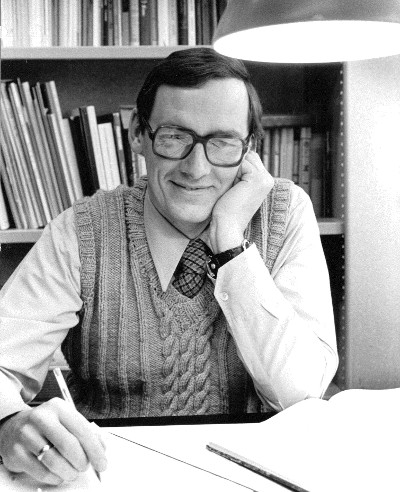 Ron Allen (Photo courtesy of Seth Shostak)
Ron Allen (Photo courtesy of Seth Shostak)
Ronald J. Allen
Contributed by Piet van der Kruit
Ronald John Allen, born November 12, 1940, was Canadian by birth. His parents were a financial advisor and a day-care center operator and he was the middle of three children. In 1962, he obtained a bachelor's degree in physics from the University of Saskatchewan, his native province. He went on to a Master and PhD at the Massachusetts Institute of Technology, completing his studies in 1967. In the same year he married Janice (Jan) Nielsen and moved to the Meudon Radio Observatory near Paris on a National Research Council of Canada Fellowship. In January 1969 he started an appointment as a postdoctoral researcher at what was then called the Kapteyn Astronomical Laboratory (now the Kapteyn Astronomical Institute) in Groningen, the Netherlands. He was attracted by the then almost-completed Westerbork Synthesis Radio Telescope. After a short spell at the Institute of Astronomy at Cambridge, Ron joined the permanent staff of the Kapteyn Institute in 1972.
His interest was to a great extent in the techniques of radio astronomy. He was instrumental in getting the WSRT continuum backend adapted to observe the 21-cm line of neutral atomic hydrogen (HI). With this '80-channel line receiver' the first HI images of galaxies were made, notably of Messier 101 and NGC 891, showing the presence of spiral structure and the overall extent of the HI. In hindsight this initiative to turn the WSRT into a spectral line machine was fundamental for the Kapteyn Institute's international reputation in galaxy research covering a wide range of topics: spiral structure, dark matter distribution in galaxies, galaxy interactions, etc.
He had a keen interest in the structure of galaxies, especially spiral structure and star formation, but was also an important driving force in setting up effective and interactive reduction procedures for 21-cm line observations from Westerbork. To this end Ron supervised the provision of a dedicated state-of-the-art reduction and visualization facility with I2S equipment and the development of the Groningen Image Processing SYstem GIPSY. Together these provided the most sophisticated spectral line visualization and reduction facility in the world. To help train students in the use of synthesis radio techniques he was also one of the initiators of a small two-element radio interferometer built on the Groningen campus for educational purposes, the Paddepoel Quasi Radio Sterrenwacht (PQRS, also known as the Toad Puddle Radio Observatory, TPRO).
Ron was chairman of the astronomy department in 1983 when the Kapteyn Laboratory moved to its current location, the Zernike Building later renamed the Kapteynborg. He saw to it that astronomers in Groningen were among the first to use e-mail, stimulated the introduction of personal computers and arranged to have a Local Area Network installed in the institute, one of the first at the University.
In 1985 Ron and his family moved to the USA, first to the University of Illinois where he was chairman of the Astronomy Department for four years. Beginning in 1989 he worked at the Space Telescope Science Institute in Baltimore, where he also became an adjunct Professor at the Johns Hopkins University Physics/Astronomy Department. His interests focused on the structure and the physics of the interstellar medium in galaxies using radio, optical, and Far-UV observations, in particular in relation to spiral structure. He supervised a number of important PhD theses. Even after he moved to Baltimore, Ron remained a frequent visitor to the Kapteyn Astronomical Institute in Groningen and worked with Piet van der Kruit in exchanging students (and for short spells of time visiting each other there and at Baltimore), which in three cases resulted in a University of Groningen PhD thesis of which he was one of the supervisors. In the last stage of his career he was much interested in the OH radical and molecular hydrogen in galaxies, in which he a suspected significant amount of matter was hiding as cold gas that is difficult to observe.
While at STScI, Ron has held various management positions, such as head of the Computing and the Science Departments and eventually he was assigned to the Science Mission Office, where for many years he was responsible for the Hubble and Giacconi Fellowship programs. He regularly taught a course on Fourier optics and interferometry at Johns Hopkins, and many students and STScI staff and students took it. In addition, he was closely associated with mentoring and directing students. For some years Ron was also the person in charge of distributing the internal research funds provided to the Institute by a contract with NASA for research. Ron was a consistent advocate that Institute computing facilities be maintained at high levels in order to enable forefront staff research to be carried out. His gift was always being able to push for change in a diplomatic way, with his voice never raised.
Ron was a dedicated breeder of sheep, for which he obtained a diploma as shepherd at a school in Baltimore. At the count shortly before his death he held nine ewes, four rams and five lambs in the two acres of land around his home in Phoenix, Maryland.
Ron Allen died on August 8, 2020.
[The author is grateful for contributions and suggestions from a number of colleagues in Groningen and Bob Williams from StScI.]
![[IAU logo]](iau_wb_thumb.jpg)
![[URSI logo]](URSI-logo-thumb.jpg)
![[Karl Jansky at his antenna]](jansky_photo_02_thumb.jpg)
![[Reber's Wheaton antenna]](Reber_Telescope_Wheaton_thumb.jpg)
![[Dover Heights]](Dover_Heights_02_thumb.jpg)
![[4C telescope]](GB61-195_4C_telescope_thumb.jpg)
![[Ewen and horn antenna]](ewen_horn1s.jpg)
![[Dwingeloo, 1956]](Dwingeloo-1956-thumb.jpg)
![[Jocelyn Bell Burnell and Cambridge antenna used in pulsar discovery]](burnell2_thumb.jpg)
![[Lovell Telescope at Jodrell Bank]](site_1594_0001-500-334-20180316163019-thumb150.jpg)
![[Wilson, Penzias, and Bell Labs horn antenna]](wilson-penzias-horn_thumb.jpg)
![[6-m Millimeter Radio Telescope in Mitaka, Japan]](6m-thumb.jpg)

